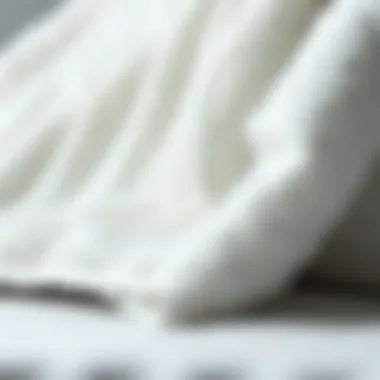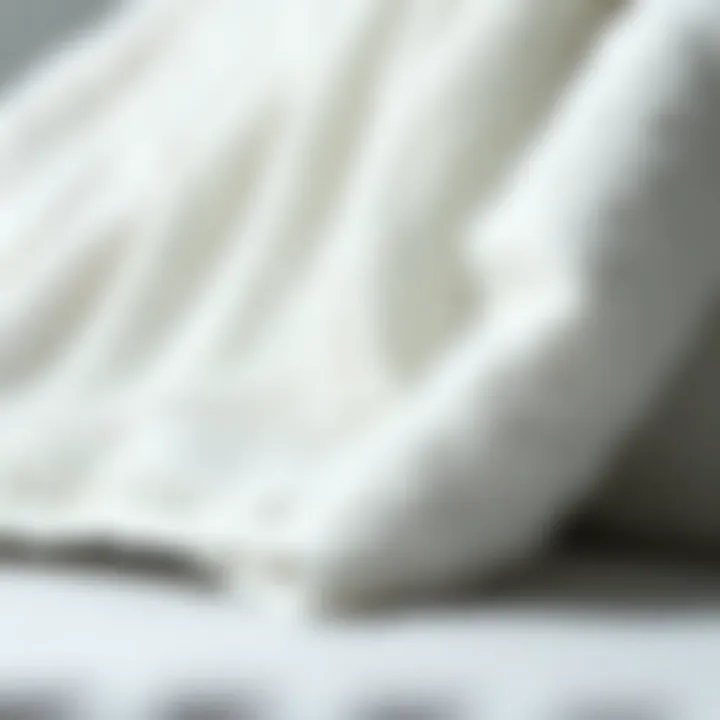Understanding Antimicrobial Quick Dry Towels: Key Benefits


Intro
In today’s fast-paced world, the simple act of drying off is getting a noteworthy upgrade. Antimicrobial quick dry towels are not just another accessory in your bathroom; they're an innovation aimed at enhancing hygiene and convenience. These towels are designed to withstand the wear and tear of everyday life while keeping unwanted microbes at bay. The conversation around them grows with each passing season, making it essential for both consumers and industry professionals to grasp what makes these towels unique.
This article aims to unpack the various aspects of antimicrobial quick dry towels. From their material composition to their multiple applications, we will delve into how these towels not only serve their traditional purpose but also contribute to a cleaner living environment. Furthermore, we’ll provide insights on how to select the right quick dry towel that aligns with your needs.
Understanding antimicrobial technologies can feel like peeling an onion, with layers of both benefits and considerations coming into play. As we stroll through this guide, you’ll discover not only how these towels perform but also ways to maintain them effectively—making them an excellent investment for the home and beyond.
Let’s jump into the nitty-gritty part of this topic, starting with the essential fabric attributes that set these towels apart.
Intro to Antimicrobial Quick Dry Towels
In the modern age, as hygiene becomes an ever-pressing concern for many individuals, the search for effective solutions intensifies. Enter antimicrobial quick dry towels, a versatile addition to the world of personal care and household products. These towels not only provide the essential function of drying but also offer added layers of protection against bacteria and other microorganisms, making them an increasingly popular choice for various applications. This article aims to delve into their unique characteristics, functionality, and the myriad benefits they bring.
Definition and Overview
Antimicrobial quick dry towels are made from specialized fabrics designed to inhibit microbial growth. The term "antimicrobial" refers to substances that kill or prevent the growth of microorganisms, including bacteria, fungi, and viruses. When combined with quick-drying properties, these towels offer users a robust solution to common hygiene problems. By utilizing materials such as polyester or nylon, often treated with antimicrobial agents like silver ions, these towels not only dry quickly but also resist odor and extend shelf life. Their ability to wick moisture and dry rapidly makes them particularly suited for active lifestyles, whether at the gym, beach, or on the go.
Their appeal lies not just in functionality but in the peace of mind they provide. Users can feel confident that their towels are less likely to harbor harmful bacteria or unpleasant smells after use, thus enhancing the overall experience of cleanliness.
Historical Context
The concept of antimicrobial materials is not entirely new. Early versions can be traced back to ancient civilizations where herbs and natural substances were used to stave off infection and preserve cleanliness. However, the leap into modern fabric technology began in the latter half of the 20th century.
In the 1960s, the advent of synthetic fabrics brought about new possibilities in terms of textile applications. With the growing concern over infectious diseases, researchers began to experiment with various agents that could be infused into fabrics to inhibit microbial growth, leading to the creation of antimicrobial textiles. Today’s antimicrobial quick dry towels are the result of decades of evolution in textile science. As public awareness of hygiene-related issues has heightened—especially highlighted by recent global health events—the demand for such towels has surged.
"The future of textiles lies not just in aesthetics but in their ability to contribute to health and well-being."
By examining their material composition and functionality, it becomes clear that these towels represent a significant innovation in the textile industry, appealing to fashion designers, retailers, and everyday consumers seeking both style and substance.
Material Composition
Understanding the material composition of antimicrobial quick dry towels is crucial, as it directly influences their performance, durability, and overall effectiveness in various applications. The right fabric can make all the difference, ensuring not just functionality but also enhancing the user experience. In this section, we will dive into the specific fabrics used in these towels and the treatments that render them antimicrobial, providing insights that are valuable for fashion designers, retailers, and stylists alike.
Types of Fabrics Used
When it comes to quick dry towels, fabric selection is top notch. Several high-quality materials are utilized to ensure rapid moisture absorption and swift evaporation. Most commonly, you will see:
- Microfiber: This fabric is often made from a blend of polyester and polyamide. Its fine fibers create a dense fabric that absorbs water well. Microfiber towels dry quickly due to their high surface area, which aids in moisture wicking.
- Bamboo Fiber: Known for its natural antibacterial properties, bamboo fiber also has excellent absorbency and dries quickly. It’s a sustainable choice, appealing to environmentally conscious consumers.
- Cotton Blends: Some towels combine traditional cotton with synthetic fibers. This blend enhances durability while maintaining cotton's softness. Cotton alone absorbs moisture but tends to retain water longer than synthetic options.
It’s important for buyers to consider what fabric best fits their needs. For example, microfiber is often the choice for athletes due to its lightweight nature and efficient drying capability. Meanwhile, bamboo towels may attract those looking for more eco-friendly options.
Antimicrobial Treatments
While the choice of fabric plays a significant role, the antimicrobial treatments applied to these towels further elevate their utility. These treatments effectively inhibit the growth of bacteria, mold, and mildew, ensuring the towel remains clean and hygienic over time.
Some common treatments include:
- Silver Nanotechnology: Incorporating silver ions into the fabric can significantly reduce microbial presence, providing a long-lasting antibacterial effect. This unique approach is increasingly favored in sports towels and personal care.
- Tea Tree Oil Infusion: A more natural alternative, some towels are infused with tea tree oil, leveraging its inherent antibacterial properties. This method is particularly appealing to those with sensitive skin or allergies.
- Bacteriostatic Chemistries: These are chemical treatments developed specifically to hinder bacterial reproduction. Unlike traditional methods, these chemicals ensure that the fabric remains effective even after multiple washes.
The importance of antimicrobial treatments cannot be overstated. Not only do they maintain towel integrity, but they also offer a layer of protection for the user, especially in environments where hygiene is paramount, such as gyms or hospitals.
By understanding the materials used and the treatments applied, designers and retailers can make educated choices about which products to offer. It emphasizes that not all quick dry towels are created equal; factors such as fabric and antimicrobial technologies contribute immensely to performance and user satisfaction.
For more details on materials and their properties, you may refer to resources like Wikipedia on Microfiber or Britannica on Bamboo Fiber.
Mechanism of Action
Understanding how antimicrobial quick dry towels work is crucial to appreciate their functionality and benefits. The mechanism of action not only explains the science behind these towels but also showcases the advantages they hold over traditional towels. By grasping this concept, users, be it fashion designers, stylists, or everyday consumers, can make informed decisions that enhance hygiene while embracing convenience.
How Antimicrobial Agents Work
Antimicrobial agents in these towels are the unsung heroes that combat bacterial growth, helping to maintain cleanliness and freshness. These agents are usually embedded within the fibers of the towel during the manufacturing process, ensuring they start working right from the first use. Here's how they function:
- Disrupting cell walls: Many antimicrobial agents target the cell walls of bacteria. By penetrating the walls, they cause the bacteria to rupture and ultimately die.
- Inhibiting reproduction: Some agents interfere with the bacteria's ability to reproduce. This means that not only are the existing germs eliminated, but new ones are less likely to emerge.
- Long-lasting protection: Unlike some products that offer temporary effects, the antimicrobial properties in quick dry towels are designed for longevity. They continue to combat microbes through multiple uses and washes, providing ongoing protection.
The result is that these towels offer a moisture-wicking surface designed to dry quickly while actively combating the growth of bacteria and mold. As such, families, fitness enthusiasts, and travelers can utilize these towels with peace of mind, knowing they are reducing the risk of contamination.
Comparison with Conventional Towels


When lined up against conventional towels, antimicrobial quick dry towels emerge as a clean winner in several ways. Here’s a look into the crux of their differences:
- Hygiene: Conventional towels can harbor and promote bacterial growth due to their moisture-retaining properties. Those everyday towels left damp can become a breeding ground for germs. In contrast, the quick-dry capabilities paired with antimicrobial agents means these towels are less likely to smell musty or harbor microbes.
- Maintenance: Traditional towels often need frequent washing to maintain hygiene standards. With antimicrobial quick dry towels, the additional microbial protection allows users to wash them less frequently without sacrificing cleanliness.
- Durability: Conventional towels may wear down with regular washing, losing their absorbency and odors gradually rise over time. Antimicrobial towels, on the other hand, remain effective through repeated wash cycles, maintaining their structure and longevity.
In summary, the mechanism of action behind antimicrobial agents in quick dry towels clearly displays their superiority over standard options. It's a science-backed way of ensuring users can enjoy the dual benefits of hygiene and convenience, making them an attractive choice for an audience deeply invested in style and functionality.
"The product protects itself against bacteria, making even regular wet scenarios safer and more hygienic."
For anyone interested in keeping towels fresh and clean—be it at home, at the gym, or while traveling—the science behind antimicrobial quick dry towels beholds a treasure trove of benefits worth considering.
Benefits of Antimicrobial Quick Dry Towels
The relevance of antimicrobial quick dry towels has gained considerable attention in recent years. The unique properties offered by these towels not only enhance hygiene but also cater to convenience and efficiency in diverse settings. Since they’re designed to combat microbial growth while facilitating rapid moisture evaporation, these towels positively influence daily routines and specific uses, from gyms to travel kits.
Hygiene and Bacterial Growth Inhibition
One standout benefit of antimicrobial quick dry towels is their inherent ability to inhibit bacterial growth. Ordinary towels can become breeding grounds for bacteria due to moisture retention. In contrast, towels infused with antimicrobial properties, such as silver or zinc compounds, actively work to eliminate potential pathogens from their fibers. This is especially crucial in environments where hygiene is already a prime concern, like gyms or shared facilities.
When a towel dries rapidly, it reduces the amount of time moisture stays trapped in the fabric, effectively curbing the conditions that bacteria thrive in. You get peace of mind knowing that the towel you use after a vigorous workout won’t harbor unwanted germs. Here’s what makes antimicrobial towels particularly effective:
- Enhanced quality: The fabric often undergoes treatment processes that enhance its resistance to microbial growth.
- Odor control: By minimizing the presence of bacteria, these towels also help in keeping odors at bay, ensuring a fresh experience with every use.
"Being mindful of hygiene starts with the tools you use every day. Reducing bacterial exposure can lead to broader health benefits in the long run."
Rapid Drying Properties
Speed is a game-changer. Antimicrobial quick dry towels are designed to whisk away moisture, allowing them to dry substantially quicker than traditional options. This is particularly advantageous for individuals who lead active lifestyles. After a sweaty gym session or a refreshing swim, who has time to fuss with slow-drying fabrics?
These quick-drying towels typically utilize lightweight, porous fabrics, which facilitate the evaporation process. Plus, they pack a punch when it comes to convenience since the faster a towel dries, the less likely it is to become damp and promote mold or bacterial growth. Here are some key points regarding their drying capabilities:
- Ease of use: They’re perfect for toss-in-the-bag travel, where space and dry time are a premium.
- Versatile application: Great for outdoor use, hot yoga, or even beach trips without the hassle of wet towels hanging around.
Durability and Longevity
Antimicrobial quick dry towels aren't just a short-term investment. Their design typically combines durability with longevity, meaning they take what you throw at them and keep on ticking. Fabrics engineered for strength are often paired with antimicrobial treatments, ensuring the towel can withstand repeated washes without compromising either function or performance.
When you’re investing in towels made for long-term use, it’s worth noting:
- Resilience against wear and tear: The blend of durable fibers and antimicrobial treatments allows towels to endure heavy usage.
- Cost-efficiency: Although they may have a higher upfront cost compared to traditional towels, they save consumers in the long run due to their extended lifespan and reduced need for replacements.
In summary, antimicrobial quick dry towels deliver a trifecta of benefits. From hygiene and rapid drying to durability, they address essential needs for varied users while elevating everyday experiences. This innovation not only improves personal care routines but also significantly enhances health and safety in everyday environments.
Applications in Daily Life
In exploring the multifaceted role antimicrobial quick dry towels play in our day-to-day activities, one might realize their far-reaching advantages that extend beyond mere hygiene. Understanding where these towels fit into various contexts of our lives helps us to appreciate their full potential. Whether in home settings, during sports activities, or while traveling, these innovative textiles offer unique benefits that enhance convenience and promote well-being.
Home Usage
When it comes to the home environment, antimicrobial quick dry towels stand out for their practicality and hygiene benefits. In kitchens and bathrooms, where moisture can foster bacterial growth, these towels serve as a frontline defense against unwanted germs. Using a towel that dries faster means less time for bacteria to breed, providing a cleaner experience for the family.
In addition, the option to include such towels in daily routines aids in establishing a healthier home. The effectiveness of these towels makes them an essential tool for tasks such as drying dishes, wiping counters, or even during kids' bath time. A notable feature is how they retain their antimicrobial properties after multiple washes, thus maintaining their effectiveness for longer periods. Examples like the product brand ‘Bamboo Health’ have gained attention for their eco-friendly materials and robust performance against bacteria, making them a popular home choice.
Sport and Fitness Contexts
For athletes and fitness enthusiasts, the benefits of antimicrobial quick dry towels amplify significantly. The dynamic nature of sports involves high perspiration levels, promoting bacterial growth in traditional towels. Utilizing quick drying options ensures moisture is whisked away rapidly, reducing the risk of unpleasant odors and skin irritations associated with damp fabric.
These towels are lightweight and convenient, making them ideal companions for gym bags. Whether it’s a yoga class, a run in the park, or intense weight training, the ability to maintain hygiene is paramount. Brands like ‘Oiselle’ focus on producing quick drying fabrics that boast antimicrobial technology, catering specifically to the active lifestyle. Furthermore, having these towels handy after workouts not only enhances personal hygiene but also reinforces mental well-being, allowing individuals to focus on their fitness goals rather than on cleanliness concerns.
Travel and Outdoors
In the world of travel, antimicrobial quick dry towels emerge as a game changer. For frequent travelers, the compact size and efficient drying capabilities allow for effortless packing and easy use. Be it a camping trip, a beach holiday, or a long flight, these towels don't just save space; they also bolster hygiene, reducing the risk of picking up germs from shared environments like airports or communal facilities.
Some noteworthy examples include travel destinations with humid climates, where the high moisture can lead to fungal infections – having an antimicrobial towel helps in mitigating such risks. Travellers can enjoy peace of mind, knowing their towels are working to keep them safe from potential infections. A variety of products such as those from ‘Sea to Summit’ provide great examples of lightweight yet robust options designed specifically for the wanderlust crowd.
"Antimicrobial towels are not just a luxury; they’re becoming a necessity for every modern lifestyle, merging convenience with health across various settings."
Therefore, as the lines blur between style, functionality, and health, integrating antimicrobial quick dry towels into daily life doesn’t just make sense; it is a proactive choice. As we move through life’s busy rhythms, the practical applications of these towels allow us to maintain hygiene with effortless efficiency.
Comparative Analysis


The discussion surrounding antimicrobial quick dry towels goes beyond just their functionality; it opens a window into the considerations consumers face when choosing between various options. This section is geared towards dissecting the differences between antimicrobial and non-antimicrobial towels while also weighing the cost implications of each.
Antimicrobial vs. Non-Antimicrobial Towels
When you pick a towel, does the label saying ‘antimicrobial’ catch your eye? It should—those words represent a key benefit. Antimicrobial towels, treated with agents that deter bacteria and mold, stand apart from your classic towels, which might harbor unpleasant odors and germs over time.
Consider this: a standard cotton towel can become a breeding ground for bacteria if not dried properly, exposing you to potential health risks. On the flip side, antimicrobial towels are designed to keep odors at bay and remain fresh even after multiple uses. They dry faster, too, which happens to reduce the chance of bacterial growth. The material itself is in many cases more breathable, preventing that damp feeling that can linger in a regular towel.
"Choosing the right towel isn't simply about softness—it's about cleanliness and health."
However, you have to think about the trade-offs. Non-antimicrobial towels, while often less expensive, may require more frequent washing to maintain hygiene, leading to water waste and higher energy costs.
Cost Considerations
Let’s chat about the bottom line. Antimicrobial quick dry towels, due to their advanced technology and treatment processes, can come with a heftier price tag. However, their longevity often offsets this initial investment. You’ll find that they don’t require as much washing, saving you time and utilities, meaning they can become more economical over their lifespan.
When evaluating costs, consider the amount you spend on detergent and the water bills from frequent laundry if you opt for standard towels. Additionally, if you're using these towels in a professional setting, whether it’s a gym or spa, the cost-benefit analysis may reveal that investing in antimicrobial options enhances your brand's reputation and cultivates customer trust.
In summary, while antimicrobial towels may require a larger upfront cost, their advantages, like hygiene, reduced maintenance, and prolonged usability, make them highly beneficial in the long run for both personal and commercial needs. Take the time to weigh the pros and cons and factor in your specific requirements and environment.
Ultimately, the choice between antimicrobial and non-antimicrobial towels boils down to your needs—health and hygiene or price? Whatever path you choose, having a solid understanding of the options available is key to making an informed decision.
For more detailed comparisons between product types, you can explore credible resources like Wikipedia and Britannica for a broader understanding.
Environmental Impact
In an age where environmental consciousness is paramount, it is essential to examine the environmental impact of antimicrobial quick dry towels. These towels offer not only a greater sense of hygiene but also pose fewer threats to our planet. Understanding their environmental footprint helps inform user choices and promotes sustainability across various industries.
Sustainability of Materials Used
When it comes to the sustainability of antimicrobial quick dry towels, the focus often falls on the materials utilized in their production. Many of these towels are made from synthetic fibers such as polyester or nylon, which, while durable, have come under fire for their ecological toll during manufacturing and disposal. However, recent advancements have seen brands turning to more sustainable sources, combining these synthetic fibers with eco-friendly materials like bamboo or recycled plastics.
- Bamboo Fiber: This plant grows rapidly, requires little water, and doesn't need pesticides, making it an attractive option for those looking to tread lightly.
- Recycled Polyester: Using post-consumer plastics not only diverts waste from landfills but also reduces the need for virgin materials, leading to lower carbon emissions during production.
By opting for towels made from sustainable materials, consumers can enjoy the benefits of antimicrobial properties while also supporting a greener planet.
Recyclability and Disposal Options
Another aspect worth considering is the recyclability and disposal options for antimicrobial quick dry towels. Disposing of laundry effectively is often an afterthought for many, but choosing towels that can be easily recycled or that decompose naturally can significantly reduce landfill contributions.
Many brands are beginning to emphasize recyclable materials in their products.
- Recyclable Components: Check labels for indications that the towel can be recycled. Materials like certain types of polyester can often be recycled through specialized facilities.
- Biodegradable Alternatives: Some manufacturers are innovating with biodegradable fabrics, ensuring that when these towels reach the end of their useful lives, they return to the earth, without lingering effects on the environment.
When consumers select products with clear end-of-life disposal options, they contribute to a circular economy rather than a throwaway culture.
Purchasing Considerations
When it comes to selecting antimicrobial quick dry towels, making an informed choice is crucial. This entails understanding the various elements that contribute to the overall effectiveness, durability, and usability of the towels. Purchasing considerations not only serve the consumer's needs but also ensure satisfaction in terms of quality, price, and functionality.
Evaluating Brands and Quality
Navigating through the plethora of brands can be daunting, particularly in a crowded market where claims about antimicrobial properties abound. Evaluating brands becomes essential to ascertain their credibility. Look for companies that transparently share information about their production processes, including the types of antimicrobial agents employed and the fabrics utilized. It's wise to check if the brand’s towels are certified by recognized standards or have positive reviews from third-party testing.
Consumer feedback and testimonials often provide valuable insight. Look for brands that consistently receive high ratings for both performance and quality. It’s advisable to consult forums or discussions on platforms like Reddit or Facebook, where users can share their real-world experiences.
To streamline your decision, consider the following factors:
- Material Quality: Is the towel made from high-quality fibers that promote efficient drying and comfort?
- Antimicrobial Efficacy: What specific treatments are used, and how effective are they against common pathogens?
- Brand Reputation: Does the brand have a history of producing reliable towels?
Ultimately, the details about a towel's brand and quality may lead you to a product that meets not just your requirements but exceeds expectations.
Price Range and Value Assessment
The price range of antimicrobial quick dry towels can vary significantly based on material, brand, and technology used. It’s critical to assess whether a product is worth its cost and whether it aligns with your budget without compromising on quality.
To adequately evaluate value, think about both short-term and long-term benefits. While cheaper towels might save you money initially, they may not perform as well or last as long, potentially leading to more frequent replacements. In contrast, investing in a higher-quality towel can pay off over time due to its durability and enhanced functionality.
Consider comparing multiple products within your budget:


- Lower Price Range: Often includes less durable materials. May not feature advanced antimicrobial properties.
- Mid-Range Options: Balances performance with cost. Usually offers reliable quality and reasonable durability.
- Premium Choices: High-end towels often feature cutting-edge technology and superior materials but require a higher investment.
Care and Maintenance
When it comes to antimicrobial quick dry towels, the importance of care and maintenance cannot be overstated. Proper handling can prolong the lifespan of these towels, ensuring that they retain their functional properties over time. As such, understanding specific care techniques becomes crucial, not just for the longevity of the towels but also for maintaining their effectiveness in inhibiting microbial growth.
Washing Techniques for Longevity
Washing antimicrobial towels requires a bit of thought to preserve the important properties that lend the towels their unique functionality. Here are some key practices worth considering:
- Water Temperature: Use warm or cold water for washing. High heat can break down the antimicrobial agents embedded within the fibers, which can reduce their efficacy.
- Detergent Choice: Opt for a mild detergent, avoiding fabric softeners and bleach. Fabric softeners can create a coating on the fibers, reducing absorbency, while bleach may compromise the antimicrobial treatments.
- Washing Frequency: Aim to wash these towels after a few uses, especially when used in high-moisture areas like kitchens or gyms.
- Drying Method: Air drying is best, but if you prefer a dryer, use a low heat setting. This not only helps prevent damage to the antimicrobial agents, but it also helps reduce the risk of fading.
By applying these washing techniques, users can enjoy the full benefits of antimicrobial quick dry towels, while also safeguarding their investment.
Storage Recommendations
How you store these towels is just as pivotal as how you wash them. Mismanagement in storage can lead to dampness and consequently mold or bacteria growth. Below are storage best practices to consider:
- Dry Environment: Always store towels in a dry, ventilated area. Avoid damp closets or laundry baskets if you want to maintain the hygiene that these towels are designed to provide.
- Avoid Folding Over Wet: Make sure towels are completely dry before folding them. This simple step can go a long way in preventing unwanted smells and bacterial colonization.
- Organizational Approach: Consider reserving a separate section of your linen closet specifically for quick dry towels. This not only keeps them organized but also prevents cross-contamination with non-antimicrobial fabrics.
Tip: Storing towels in cotton bags can help maintain their freshness and ensure they are airflow-friendly.
By understanding proper care and storage, users can extend the life of their antimicrobial quick dry towels while ensuring they remain effective. Whether it’s a designer in search of the perfect fabrics or a retailer looking to provide quality products, being knowledgeable about maintenance practices only adds to overall satisfaction.
Further information can be found on resources such as Wikipedia, and check Britannica for detailed fabric choices.
Future Trends in Towel Technology
The world of textiles continually evolves, and towels are no exception. With emerging technologies and changing consumer preferences, the future of towel design and functionality, particularly in the realm of antimicrobial quick dry options, holds promise for enhanced user experience and sustainability. This section will explore some of the innovations reshaping towel technology and how they align with contemporary demands in hygiene, practicality, and environmental responsibility.
Innovations in Fabric Technology
Recent advancements in fabric technology have spurred the evolution of antimicrobial quick dry towels. These towels, now crafted from innovative materials, are more effective at preventing bacterial growth and ensuring faster drying times. For instance, we see the rise of blended fabrics that incorporate natural fibers like bamboo with synthetic materials designed for rapid moisture wicking. This combination not only enhances absorbency but also offers antibacterial properties without relying solely on chemical treatments.
Furthermore, the introduction of nanotechnology in towel production has ushered in a new era. Microscopic particles are woven into the fabric, enabling them to resist dirt and microbes more efficiently. As a result, towels can maintain their freshness longer, making them ideal for both everyday use and specialized environments like gyms and spas where hygiene is paramount.
- Enhanced Breathability: New fabric designs allow for better air circulation, which in turn assists in quick drying and temperature regulation—keeping towels lightweight and effective.
- Durability: With improved textile engineering, these towels are better suited to withstand frequent washing without losing their antimicrobial properties, thus providing value for money over time.
Emerging Market Opportunities
In tandem with innovations in fabric technology, there is a substantial market opportunity arising from the growing awareness of hygiene and sustainability. Consumers today are not just looking for functional items; they want products that align with their values.
The demand for eco-conscious products has paved the way for brands to focus on ethically sourced materials and low-impact manufacturing processes. Companies are investing in organic and recycled materials, reflecting a broader trend towards sustainability in textile production. For instance, a towel that is made from recycled plastics not only emphasizes innovation but also appeals to environmentally minded shoppers.
Additionally, the wellness trend continues to shape purchasing decisions. With a heightened focus on cleanliness, antimicrobial towels can be marketed not just as accessories but as essential items in personal care routines. The sports industry, in particular, is a fertile ground for these products, as athletes seek to minimize the risk of infections from shared equipment or facilities.
In summary, the future holds significant promise for towel technology. With ongoing innovations in fabric and a keen eye on market demands, the landscape for antimicrobial quick dry towels is ripe for development. As brands adapt to these changes, they stand to not only meet consumer needs but also position themselves as leaders in a rapidly evolving marketplace.
“In the race for hygiene and convenience, those who innovate will lead the way.”
By keeping an eye on these trends, professionals in the fashion and retail industries can adapt their strategies and offerings to align with the needs and preferences of modern consumers, paving the way for a new standard in towel technology.
Ending
Wrapping up the discussions surrounding antimicrobial quick dry towels, it becomes clear that these products bring a wave of advantages to the table. Their ability to inhibit microbial growth is pivotal in promoting hygiene across various environments. Every element discussed, from the materials used to the care and maintenance tips, showcases how well-thought-out these towels are, making them suitable for a range of applications.
Summarizing Key Points
To distill the essence of our exploration:
- Material Influence: The fabric composition greatly impacts both functionality and durability. Polyester and nylon blended with antimicrobial treatments offer a potent solution against bacteria.
- Effectiveness in Hygiene: The unique properties of these towels not only aid in rapid drying but also contribute significantly to reducing the spread of harmful microorganisms.
- Versatile Applications: Whether for home use, travel, or fitness, there’s a suitable antimicrobial towel fit for every lifestyle. Each use case underscores their necessity in everyday routines.
- Environmental Considerations: Sustainable practices in manufacturing these towels reflect concern for ecological impact, appealing to environmentally conscious consumers.
Overall, understanding these facets not only emphasizes their benefits but also provides a well-rounded perspective for making informed purchasing decisions.
Encouraging Informed Choices
As we navigate an increasingly health-conscious world, choosing the right towel is not just about preferences but making mindful choices that reflect our priorities. Here are a few tips for making a better decision:
- Research Brands: Not all towels are created equal. Investigating the quality of brands, their manufacturing processes, and the reputation can save you from regrettable purchases.
- Assess Specific Needs: Evaluate what you’re looking for in a towel. Whether it's for post-workout, travel, or everyday use, ensure the towel meets your unique demands.
- Price vs. Value: While cheaper options might tempt you, investing in a quality antimicrobial towel provides long-term benefits that outweigh the initial costs. Look for durability, effectiveness, and user reviews before settling down.
With ample options available, incorporating antimicrobial quick dry towels into your life can elevate your daily hygiene and comfort. Each selection made is a step toward a cleaner and more efficient lifestyle.
"In the world of textiles, knowledge is power, and the informed consumer is an empowered one."
For more insights, check out resources like Wikipedia, Britannica or community insights from Reddit.
Understanding the importance of these details can guide consumers toward better choices.



